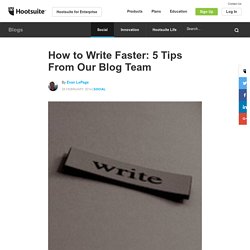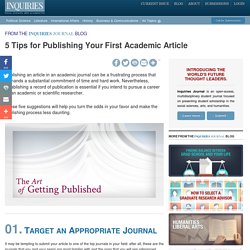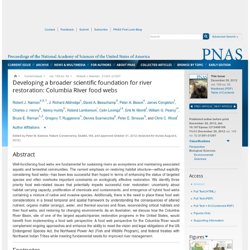

Writing a Literature Review: Six Steps to Get You from Start to Finish. Writing a literature review is often the most daunting part of writing an article, book, thesis, or dissertation.

"The literature" seems (and often is) massive. I have found it helpful to be as systematic as possible in doing this gargantuan task. This post describes one system for writing a literature review. In their book, Destination Dissertation: A Traveler's Guide to a Done Dissertation , Sonja Foss and William Walters describe a highly efficient way of writing a literature review. How to Write Faster: 5 Tips From Our Blog Team. Content is king, right?

We’ve all heard that cliché because we’re working in the era of blogging and thought leadership, where every position and department in the workplace is being asked to produce more content. But it doesn’t write itself. HR professionals, developers, salespeople, and other employees with no writing background are increasingly expected to create good content, and to do it quickly. That’s not an easy task. To help you hone your skill, here are 5 tips on how to write faster. Skip the Introduction The first paragraph, known as the “lead,” is a very important part of any piece of writing. Your lead should captivate the reader, giving them no choice but to read on while also offering a snapshot of what the entire text contains. Fast writers often skip their introduction. 5 Tips for Publishing Your First Academic Article - Inquiries Journal.
Target an Appropriate Journal It may be tempting to submit your article to one of the top journals in your field: after all, these are the journals that you and your peers are most familiar with and the ones that you will see referenced over-and-over again in the literature you consume.

But remember, the top professional journals are exceedingly competitive. The types of academic projects that get published in such journals are generally groundbreaking studies of great significance, many of which rely on the scholarship of multiple authors. Moreover, these articles are often the result of considerable research budgets and institutional support. Not to mention the decades of experience and the publication records of the authors. If you’re strategic in selecting a journal to target, you will greatly increase the odds of publishing your first article. Headline and title phrase helper. Headline and title phrase helper Are you a writer looking for inspiration?

This phrase generator can help authors, journalists, sub-editors, copywriters and songwriters to come up with headline and title ideas. It searches a database of more than 100,000 phrases and existing titles. (See the notes below for background information.) The phrase generator uses a specially filtered subset of the Wiktionary database for standard phrases, plus a private database of book, film and music album titles. Use the ‘include two-word phrase’ option to give you (generally) loads more results; or the ‘exact word’ option to reduce the number of results by ignoring stems (ie the search word plus ‘ing’, ‘ed’ etc). Oxford Dictionaries. Are you uncertain about when to use an apostrophe?

Many people have difficulty with this punctuation mark. The best way to get apostrophes right is to understand when and why they are used. There are two main cases – click on the links below to find straightforward guidance: People are often unsure about whether they should use its (without an apostrophe) or it’s (with an apostrophe). For information about this, you can go straight to the section it's or its? Apostrophes showing possession. MLA Formatting and Style Guide.
Summary: MLA (Modern Language Association) style is most commonly used to write papers and cite sources within the liberal arts and humanities.

This resource, updated to reflect the MLA Handbook (8th ed.), offers examples for the general format of MLA research papers, in-text citations, endnotes/footnotes, and the Works Cited page. Smarter online research - annotate, organize & collaborate on web pages. Egg Timer. 1300990757_717.pdf. Why Sentence Structure Matters. Although ordinary conversation, personal letters, and even some types of professional writing (such as newspaper stories) consist almost entirely of simple sentences , your university or college instructors will expect you to be able to use all types of sentences in your formal academic writing.

Writers who use only simple sentences are like truck drivers who do not know how to shift out of first gear: they would be able to drive a load from Montréal to Calgary (eventually), but they would have a great deal of trouble getting there. If you use phrases and clauses carefully, your sentences will become much more interesting and your ideas, much clearer. This complex sentence develops a major, central idea and provides structured background information: Since it involves the death not only of the title character but of the entire royal court, Hamlet is the most extreme of the tragedies written by the Elizabethan playwright William Shakespeare.
Written by David Megginson. Researh-paper-outline-sample.jpg (2016×2336) Developing a broader scientific foundation for river restoration: Columbia River food webs. Author Affiliations Edited by Peter M.

Kareiva, Nature Conservancy, Seattle, WA, and approved October 31, 2012 (received for review August 6, 2012) Abstract Well-functioning food webs are fundamental for sustaining rivers as ecosystems and maintaining associated aquatic and terrestrial communities. The current emphasis on restoring habitat structure—without explicitly considering food webs—has been less successful than hoped in terms of enhancing the status of targeted species and often overlooks important constraints on ecologically effective restoration.